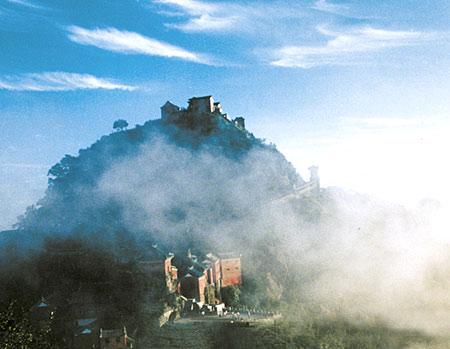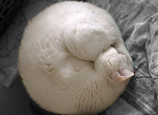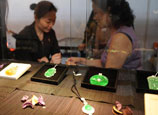
 |
| Tianzhu Peak—the main peak of the Wudang Mountains surrounded by clouds (CNTV) |
Authenticity and completeness
The Ancient Building Complex in the Wudang Mountains has gone through many years and the existing four Taoist palaces, remains of two palaces, two Taoist temples and many shrines and temples have preserved their original state in terms of layout, planning, style, materials and craft.
Heritage value
The existing large scale, high planning, strict structure, exquisite decorations and numerous idols and objects of the buildings in the Wudang Mountains are unique in the existing Chinese Taoist architecture.
The Ancient Building Complex in the Wudang Mountains reflects the elite decorative art of ancient Chinese architecture, and reached a perfect state in architectural art and aesthetics. The Ancient Building Complex in the Wudang Mountains has a tight general plan, is clear distinguished, and a rational layout. The selection of the architectural sites pays much attention to the environment and the layout of the mountain and river. The complex has many kinds of building types and uses many different materials and they are either magnificent or small and exquisite, surrounded by mountains or border on the dangerous cliffs. Therefore, the complex has reached a high harmonious relation between buildings and nature. The complex has strong architectural rhythm and talented creativity. The various plans, structures, decorations and furnishings all come up to a higher technological and artistic achievement.
The building complex in the Wudang Mountains was constructed when Emperor Zhu Di was expanding diplomacy, he advocated Taoism in domestic and inoculated people with the idea that God granted imperial power in order to consolidate his governance. The building complex has an important historical and ideological meaning.
The Jin Hall in the Wudang Mountains and the statues as well as the altars in the hall are all distill gold casted in bronze, the mass of the castings is large and it was casted by using the lost wax process (wax mould) and represents the development of science and technology and the foundry industry in the early Ming Dynasty (15th century).

















 Rainstorms flood more than 10,000 cars in underground garages in Wuhan
Rainstorms flood more than 10,000 cars in underground garages in Wuhan


![]()
